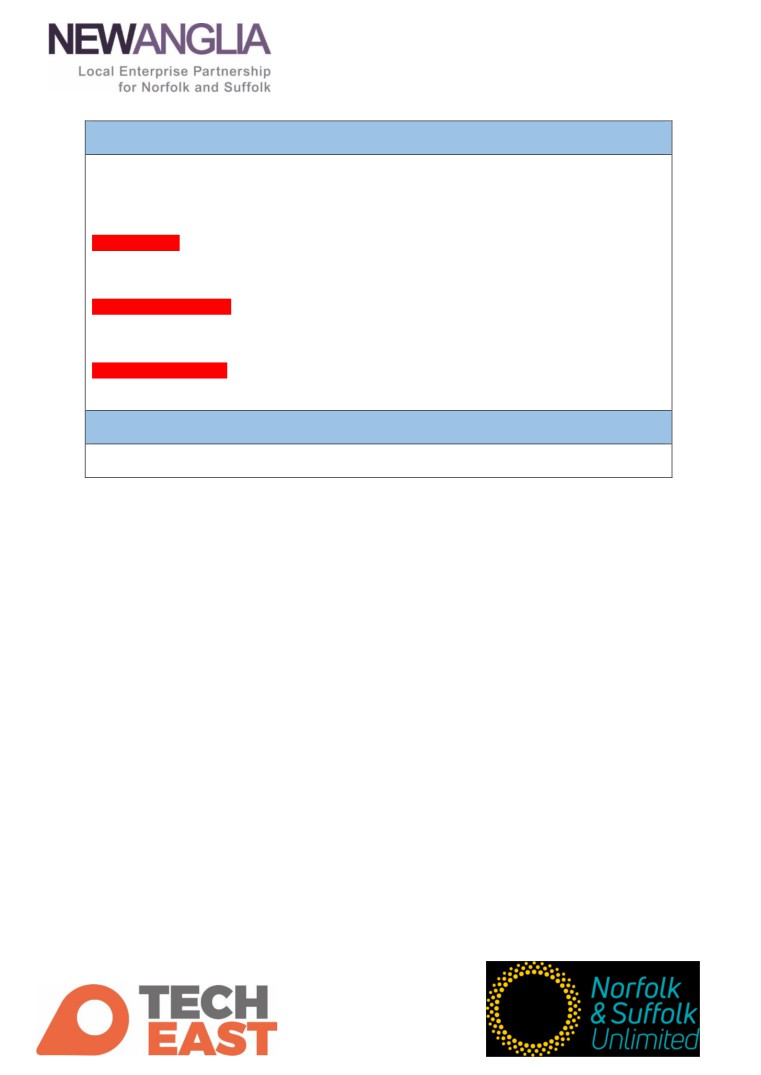Norfolk and Suffolk Digital Tech Council Meeting Minutes
Chair: Neil Miles
Date: Monday 16 September 2019; Time: 14.00-16.30
Venue: Hubble 1&2, The Hub, Adastral Park, Martlesham, Ipswich, IP5 3RE
PRESENT
Chris Starkie, New Anglia LEP;
Marlon Bowser, HTK;
Peter Brady, Orbital Media;
Maddie Coupe, New Anglia LEP;
James Duez, Rainbird;
David Dukes, Norfolk County Council;
John Fagan, Axon Vibe;
Viv Gillespie, New Anglia Colleges Rep;
Thea Goodluck, Tech Nation;
Michelle Gordon, Ipswich Borough Council;
Fiona Lettice, UEA;
Graham Masterson, KCOM;
Neil Miles, Inawisdom;
Julian Munson, New Anglia LEP;
Lisa Perkins, BT;
Jai Raithatha, Suffolk County Council;
Catherine Richards, New Anglia Colleges Rep; Tim Robinson, Tech East;
Chris Sargisson, Norfolk Chamber of
Sarah Steed; Norwich University of the Arts;
Commerce;
Mark Thomas, Coderus;
Steph Thorne, University of Suffolk;
Ellen Tilney, Norwich City Council;
Brigette Currin, Tech East (Taking Minutes)
Apologies
John Dugmore, Suffolk Chamber;
Hayley Johnson, Hoseasons;
Dominic Keen, Britbots;
Mike Kingston, Mason Advisory;
Dean Withey, Ubisend
Delivered by:
Introductions& scene setting - Chair
The chair welcomed everyone to the first meeting of the Norfolk and Suffolk Digital Tech
Council (DTC) and thanked them for giving up their valuable time to commit to being part of
the DTC. He continued by giving a short introduction, explaining that the DTC has been set
up under the sponsorship of New Anglia LEP and the coordination and accountable body of
Tech East to be the voice of the tech sector. Everyone has had a personal invitation to be
part of the DTC for Norfolk and Suffolk. As leaders in the Digital Tech sector they have the
ability influence key people for the sector to help drive the agenda and success of the
council. The first meeting's objective is to get the attendees input into shaping of the council.
Each member of the DTC then each gave a brief introduction and outlined what success for
the digital sector means to them. A summary of the key points is listed below.
• Success stories putting the region on national and international map
• Contribution to economic growth
• Collaboration / Vibrant Community / Events
• Access to capital to grow
• Successful businesses framing the narrative
• Physical base for co-working, connecting and collaborating
• Working as a single community
• Building on the success Tech East has started
• Closer university links and across the education sector with businesses showing
young people the opportunities within the sector
• Being a tech community of people who are proud of the region and shout out about
the work/lifestyle balance and great tech businesses here
• Retaining skills within the region
• Helping start-ups grow
• Cross sector collaboration
• Digital & business communities linked
Delivered by:
Developing the Digital Tech Council - presented by Chris Starkie
Chris Starkie presented the history behind the formation of the DTC and why this Council has an
important role to play.
In 2017, the LEP published the Economic Strategy for Norfolk and Suffolk, setting out the
ambition for the region, and the roadmap for delivering on those ambitions.
In
2017, the Government also published the Industrial Strategy White Paper, setting out a long-
term plan to boost productivity in the UK.
The Industrial Strategy looks at productivity through five foundations
• Ideas - innovation
• People - skills and earnings, the labour market
• Infrastructure - including digital infrastructure
• Business Environment - business support and finance
• Place.
These 5 foundations are what have provided the framework for establishing the Digital Tech
Council.
The Local Industrial Strategy (LIS) is the next stage in the evolution and builds on the Economic
Strategy to improve productivity and drive growth. The LIS is currently under review and being
discussed with ICT being listed as a priority.
The LEP is here to support private sector growth through investing in infrastructure, skills and
businesses support.
Four new projects which will boost skills, innovation and productivity in Norfolk and Suffolk are
underway
The overarching ambition in the Local Industrial Strategy for the sector is to grow and secure
ICT and digital creative clusters at Adastral Park and Norwich as national assets. Establish
unique case advanced IoT, testbeds to support large scale experiments. The LEP can only
achieve this if we work together.
Delivered by:
The DTC has been set up from a vision as a partnership which brings together the digital tech
sectors which strengthens the strategic relationships between industry, local and national
government and academia. The DTC will shape and inform policy and make the case to
government and the LEP for investment in areas which support digital businesses such as skills,
innovation, access to finance and profile.
The meeting today should agree the broader development of what we should be doing at the
DTC and is made up of Private Sector, Public Sector (local), Education and Research, Industry
Groups and Government (national).
The DTC will bring this altogether by looking at different themes for example Skills, Profile and
Promotion, Lobbying and Legislation, Innovation and Investment and Finance.
The DTC needs to think about its role and responsibilities towards the Terms of Reference.
Governance and structure - Discussion on next steps - Chair and DTC
The DTC were invited to put forward their thoughts in a discussion for shaping the next steps
and approach the DTC should take.
It is suggested that the DTC meets on a quarterly basis. From this meeting a draft Terms of
Reference will be circulated for review.
The DTC had a brief discussion around the responsibilities of the role it has to play by
understanding and valuing innovation and digital creativity both within the digital tech sector and
larger organisations using tech or does it connect and feed through to other groups and sectors?
Looking at skills, apprenticeships and retaining people within the region.
Delivered by:
State of the regional Digital Tech market - presented by Tim Robinson
Tim Robison presented where the digital tech sector of the region sits in the national and
global picture; key initiatives that are happening now and what the sector needs in order to
grow.
The huge growth of tech throughout the different sectors needs to be balanced between the
digitally producing tech companies, data companies, AI, Big Data or IoT and impact of cloud
computing and those companies that are being transformed by technology.
TR outlined how tech has shifted over the past 10 years and the countries that are now
leading in technology. UK is still one of the global leader in tech with AI being its greatest
strength.
From the Tech Nation Report the East of England has seen the greatest increase in capital
against all tech companies.
TR outlined the key elements that make up a healthy ecosystem.
He also outlined what Tech East has achieved to date and reiterated that the DTC needs to
continue to recognise what we have in the region and feed this back to government. There
is a diverse opportunity to link the hubs across the region, connecting people into different
places with the variety of programmes taking place across the region. Showing that this is
good place to work, to start business and to stay in the region. Having mentors to help start-
ups become successful. Tech East has prioritised a few key areas, such a Talent and Skills
since the publication of the LEP Digital Tech Skills Plan; access to finance; collaborative
workspace; innovation within and cross sector.
Delivered by:
Next steps towards an activity plan and priorities - DTC
The DTC’s discussion explored in detail what more needs to be done and where priorities
need to be made, in line with
• Skills
• Profile and Promotion
• Lobbying and Regulation
• Innovation
• Investment and Finance
Where are the priorities and actions going to be derived from and is anything missing from
the list? The DTC must be open about what it is trying to achieve. What will the success
measurables be?
There will be wider subgroups to deliver actions and it is the responsibility of the DTC to
bring these actions together.
The DTC needs to agree key ambitions and understand what is happening regionally in
order to agree and make tactile decisions.
Funding bring together all opportunities to make companies aware of what is available.
Area/Space needs expanding to allow growth development.
Profiling is key as it brings both customers and investors. The DTC can learn from other
national areas who are doing profiling well, including looking at the world stage and work to
become a part of that. Communication is fundamental in getting the message across.
Promoting Norfolk and Suffolk as a joint venture will give greater strength. Need to think
about the opportunities outside the region and collectively promote the region to those areas.
Understanding what the message is that needs to be taken to the external audience. Look
at current strengths for the region.
Business Growth Helping businesses to grow. Nominate top companies that the DTC can
get behind to help develop into a success story. Companies selected need to develop a high
profile exit. Tech East 100 list can be starting point for companies to select from.
Skills local businesses need to promote opportunities to young people by allowing work
experience. Opportunities such as the Skills Fair on 10th October are free to exhibit at to
demonstrate the areas of employment in the tech sector. Improving on apprenticeship
opportunities. The DTC reflected on the current problems the region is experiencing around
skills and suggestions were made to look at other regions, learn from what they are doing
well to implement a strategy to work towards. It concluded that continued work and
engagement with the Digital Skills Task Force is key.
Regionally bringing together Norfolk and Suffolk as a whole and not having disjointed areas.
Making businesses aware that they are part of a cluster. Need to pull together to use
combined business strengths. The DTC can look for links to build knowledge base and build
case studies. Have a central location to make resources available in one place such as
funding opportunities rather than having in a variety of places and not know where to go
look.
Delivered by:
Next steps towards an activity plan and priorities - DTC cont.
Terms of Reference to be written up and agreed at the next DTC meeting. Identify
members from the DTC to take the lead on the agreed set of priorities, setting objectives
and what DTC wants to achieve. The DTC can coordinate these activities, but work takes
place outside of meetings and reported back to DTC at the quarterly meeting.
ACTION: LEP
In order to continue the discussion outside of the DTC meetings James Duez suggested
setting up a LinkedIn group. The DTC agreed.
ACTION: James Duez
Peter Brady suggested to the DTC that a one-page document be drafted on what is already
available in the region.
ACTION: Peter Brady
AOB
With no other business to discuss the meeting was closed.
Delivered by:






